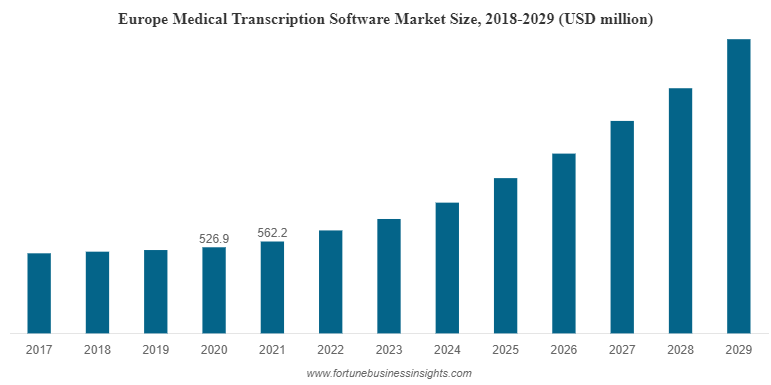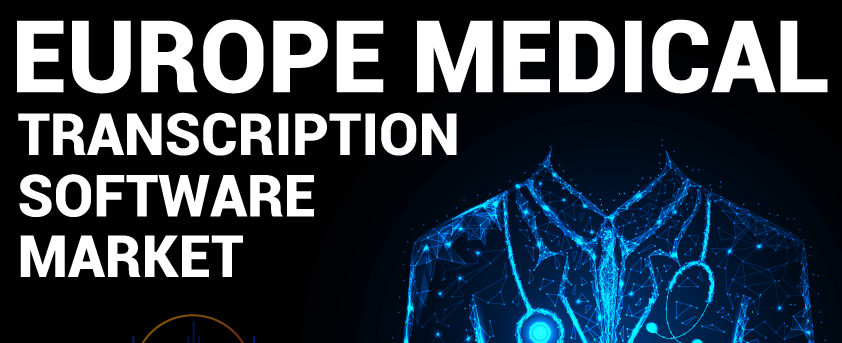Europe Medical Transcription Software Market Size, Share & COVID-19 Impact Analysis, By Deployment (Cloud/Web-based and On Premises/Installed), By End-user Facility (Hospitals, Diagnostic Centers, Clinics, and Others), By Type (Voice Capture and Voice Recognition), By End-user (Radiologists, Clinicians, Surgeons, and Others), and Regional Forecast, 2022-2029
KEY MARKET INSIGHTS
 Listen to Audio Version
Listen to Audio Version
The Europe medical transcription software market size was valued at USD 562.2 million in 2021 and is projected to grow from USD 638.1 million in 2022 to USD 1,753.6 million by 2029, exhibiting a CAGR of 15.5% during the forecast period. Based on our analysis, the market exhibited a higher growth of 22.2% in 2020 as compared to 2019. The global COVID-19 pandemic has been unprecedented and staggering, with experiencing higher-than-anticipated demand across Europe compared to pre-pandemic levels.
Transcription software's operational benefits and improved flexibility are expected to propel the Europe medical transcription software market growth rate during the forecast period. For instance, OmniMD transcription software maintains an average turnaround time of 12 hours upon receiving audio files. Medical transcription involves the process of transcribing the voice record of patients by healthcare practitioners during consultations. Physicians use these transcripts to make precise treatment decisions. Moreover, transcription software reduces the time required for clinical documentation and allows physicians to dictate from anytime, anywhere.
Additionally, regulations and acts of governments are projected to increase the adoption of clinical documentation systems, which is ultimately expected to drive the growth of the market. For instance, in May 2021, in Europe, new regulations were made, which included process descriptions for EHR manufacturers. This process description is beneficial for EHR manufacturers to fulfill the regulatory body regulations. This process description also guides manufacturers to obtain CE marks for their novel products.
COVID-19 IMPACT
COVID-19 Pandemic Led to Significant Boost in Medical Transcription Software Demand
The COVID-19 pandemic had a positive impact on the market. The adoption of digital health technologies, EHR, and telemedicine during the pandemic was responsible for the increased demand for medical transcription software.
- For instance, in April 2020, Nuance, the global leader in the Europe medical transcription software industry, launched Nuance Dragon Ambient eXperience (DAX) solution for telehealth in response to address the increase in virtual visits sparked by the COVID-19 global pandemic.
Also, the pandemic has increased awareness about the benefits of digital health technologies, leading to more robust adoption of solutions, including medical transcription solutions. Also, favorable regulatory changes lead to the broader adoption of digital health.
- For instance, in June 2020, according to the article published by King’s College London, Life Lines has enabled around 25,000 virtual hospital visits from families in the U.K.
Moreover, several market players introduced products and services for hospitals to save time in this COVID-19 crisis.
- For instance, in March 2021, Speech Processing Solutions launched Philips SpeechExec Enterprise, speech-to-text software, with fully integrated Dragon Nuance Medical One (DMO) speech recognition software.
LATEST TRENDS

Transition of Traditional Medical Transcription Services to AI-Powered Speech Recognition Solutions to Drive Market Growth
Several demerits are associated with traditional medical transcription services, such as high cost and turnaround time. The AI-powered speech recognition solution provides several benefits, such as low cost and efficient transcription.
Hence, problems associated with traditional medical transcription services can be solved with AI-powered speech recognition solutions. Therefore, the Al-powered speech recognition solution becomes a better option for conventional medical transcription services. It drives the transitional shift of traditional medical transcription services to AI-powered speech recognition solutions.
Maintaining clinical documentation is one of the essential tasks of physicians. Clinical documentation is time-consuming, but automation has enabled physicians and radiologists to invest less time in these administrative tasks.
Healthcare professionals can focus on patient treatment rather than clinical documentation. Additionally, AI-powered voice recognition solutions offer better technical aid than traditional services during radiology reporting. The above factors are responsible for transitioning conventional medical transcription services to AI-powered recognition solutions.
DRIVING FACTORS
Rising Importance of Clinical Documentation & Technological Advancements to Foster Growth
Clinical documentation is an essential aspect of patient-physician interaction, as it collects and represents all patient-related data. Clinical documentation is helpful in patient evaluation, patient data recovery, tracking of diagnostic and treatment outcomes. These applications of clinical documentation are expected to drive its growth. An increase in clinical documentation practice in developed European countries is leading to larger adoption of EHR/EMR machines.
The companies are offering Electronic Health Record (EHR) integrated voice recognition platforms to advance clinical documentation during patient consultations. For instance, in August 2020, U.K.-based Lexacom introduced a portable, standalone unit with the latest AI technology for transcription, intending to advance clinical documentation.
Along with clinical documentation, technological advancements are responsible for the market growth. Advancements in software development and integrated devices provide intelligent solutions in compact platforms, which enables physicians to provide a higher quality of consultation and treatment. Key players in the market are now focusing on developing EHR integrated transcription platforms to offer compact solutions that help perform several tasks in a short duration. For instance, in August 2021, Nuance Communications, Inc. partnered with Cooper University Health Care to expand Nuance Dragon Ambient eXperience to around 90 locations in more than 20 specialties. Ambient eXperience is the clinical intelligence solution, which documents patient encounters with accuracy in a short duration compared to traditional transcription.
Europe Medical Transcription Software’s Operational and Flexibility Benefits to Surge Product Demand
Medical transcription software offers several operational benefits, such as low turnaround time and resource requirements, compared to the traditional method; this helps physicians handle more patients. Additionally, the Natural Language Processing (NLP) algorithms in the transcription software actively transcribe the narrations into meaningful information, leading to quality diagnosis and treatment. According to Folio3, an AI business solution provider, NLP helps machines perform various complex tasks such as summarization, translation, and others. Also, NLP is useful for understanding unstructured text data.
Also, medical transcription software offers various flexibilities as it provides remote access to dictation platforms and enables physicians to dictate remotely at any time, resulting in physicians' higher adoption of medical transcription software. According to the article published in Towards Data Science, Artificial Neural Networks (ANN) are building blocks of AI tools for virtual physicians. ANN is implemented through automatic speech recognition for medical transcription in the international field.
RESTRAINING FACTORS
Lack of Network Infrastructure to Limit Growth of the Market
A strong network infrastructure is required to use medical transcription software. In some developed countries in Europe, it is mandatory to use EHR systems by law (HITECH Act 2008). However, in most of the developing countries and Europe, respective governments have not framed such policies, resulting in the lower adoption of transcription software and EHR systems. For instance, according to the European Commission, EHRs are not in actual use in most European countries.
Moreover, high-speed internet is an essential factor in running the transcription software. Most European countries have limited access to high-speed internet. However, comparatively lower internet penetration in emerging countries is limiting the adoption of these systems. According to Eurostat, 357.0 million or 8.0% of the total population of the European Union and 10.0% of the households in the European Union lack access to broadband internet. Also, according to Statista, Sweden, Norway, and Netherland registered a decrease in access to the internet in 2020.
SEGMENTATION
By Deployment Analysis
To know how our report can help streamline your business, Speak to Analyst
Cloud/Web-based Segment to Add Impetus to Market
Based on deployment, the market is segmented into cloud/web-based and on premises/installed. The cloud/web-based segment dominated the market in 2021. This segment is anticipated to grow at a comparatively higher CAGR due to increasing adoption of online health services and rising demand for cloud-based software among healthcare professionals.
On the other side, the on premises/installed segment is expected to grow at a comparatively moderate CAGR, owing to the requirement of a higher upfront cost of a one-time perpetual license fee.
By End-user Facility Analysis
Adoption of Hospital Transcription Software to Boost Market Growth
Based on end-user facility, the market is segmented into hospitals, diagnostic centers, clinics, and others. The hospitals segment accounted for the largest share in 2021. Management of extensive patient information coupled with the availability of the infrastructure is predominantly responsible for the higher percentage of hospitals in the market. Moreover, a strong focus on driven data decisions and patient-centered strategies in Europe is projected to boost the adoption of transcription software in hospitals.
The clinics segment to register the highest growth during the forecast duration due to the increasing patient pool and visits, increasing adoption by physicians, and lower turnaround time. According to the NHS, in England, in December 2021, the number of people on a waiting list for hospital treatment rose to 6.1 million; this drives more patients to clinics.
By Type Analysis
Growing Usage of Voice Recognition Software to Aid Market Growth
Based on type, the market is bifurcated into voice capture and voice recognition. The voice recognition segment accounted for a comparatively larger market share in 2021. The increasing adoption of new technology and government initiatives are propelling the growth of the voice recognition segment. Moreover, national strategies for research & development contribute to the higher market share of voice recognition software in Europe.
Besides, voice capture solutions are generally used in managing the workflow of the transcription process and are expected to decline during the forecast period due to the radical shift from voice capture to voice recognition. This radical shift is due to the advancements in voice recognition technology and their rising applications in the healthcare industry.
By End-user Analysis
Increasing Use of Transcription Software by Clinicians to Assist Market Growth
Based on end-user, the market is segmented into radiologists, clinicians, surgeons, and others (allied health professions). The clinicians' segment accounted for the highest share in 2021. Growing adoption by clinicians in Europe for maintaining patient records is responsible for the dominance of clinicians in the market.
The radiologists' segment accounted for the second-largest share and registered a significant growth due to awareness about clinical documentation among radiologists in Europe and many radiology consultants. For instance, according to the article published in Interventional News, in 2021, the U.K. had 4,277 radiology consultants.
KEY INDUSTRY PLAYERS
Innovative Product Portfolio and Strategic Collaboration of Key Players to Assist Market Growth
The competitive landscape of this market is semi-consolidated, with the top players, including Nuance Communications, Inc. and Speech Processing Solutions GmbH accounting for a significant Europe medical transcription software market share in 2021. A strong focus on developing innovative products and strategic collaboration with end-users in region and country are factors influencing the dominance of these players in the market. Nuance Communications Inc. is one of the prominent players in the market offering a wide range of products. For instance, in May 2020, Nuance Communications, Inc. launched Dragon Medical One in Denmark, Finland, and Sweden with an aim to expand its footprint in the region. Dragon Medical One provides next-level architecture and new capabilities from pre-charting through post-encounter documentation.
However, the market is also characterized by a large number of domestic players in Europe. Hence, companies are focusing on launching innovative products to gain market share during the forecast period.
LIST OF KEY COMPANIES PROFILED:
- Nuance Communications, Inc. (U.S.)
- Speech Processing Solutions GmbH (Austria)
- BigHand (U.K.)
- Tyger Valley Systems (U.K.)
- Lexacom (U.K.)
- Scribetech (U.K.) Ltd. (U.K.)
- Prescribe Digital (InventAsia Ltd.) (Spain)
- MEDISEC SOFTWARE LTD (U.K.)
- DScribe Ltd. (U.K.)
- Olympus Corporation (Japan)
KEY INDUSTRY DEVELOPMENTS:
- December 2021 – Olympus Corporation included enabling factors such as expanding the global R&D network, building a stronger medical segment and scientific affairs, and focusing more on centralized quality assurance and regulatory affairs function.
- September 2021 – The Speech Processing Solutions GmbH collaborated with Nuance Communications as an official distributor of Nuance Dragon Medical One, a cloud-based speech recognition solution for clinical documentation in Europe.
REPORT COVERAGE
An Infographic Representation of Europe Medical Transcription Software Market
To get information on various segments, share your queries with us
The market research report covers a detailed analysis of the Europe market. It focuses on key aspects such as leading companies, deployment, end-user facilities, types, and end-users. Besides this, the market report offers insights into the current market trends and highlights key industry developments. In addition to the aforementioned factors, the report encompasses several factors that have contributed to the market growth in recent years.
Report Scope & Segmentation
ATTRIBUTE | DETAILS |
Study Period | 2018-2029 |
Base Year | 2021 |
Estimated Year | 2022 |
Forecast Period | 2022-2029 |
Historical Period | 2018-2020 |
Unit | Value (USD million) |
Segmentation | By Deployment, End-user Facility, Type, End-user, and Region |
By Deployment |
|
By End-user Facility |
|
By Type |
|
By End-user |
|
By Geography |
|

Frequently Asked Questions
Fortune Business Insights says that the Europe market size was USD 562.2 million in 2021 and is projected to reach USD 1,753.6 million by 2029.
Growing at a CAGR of 15.5%, the market will exhibit steady growth over the forecast period (2022-2029).
Cloud/web-based segment is expected to be the leading segment in this market during the forecast period.
Operational benefits and enhanced flexibility of transcription software and technological advancements are likely to boost the market growth during the forecast duration.
Nuance Communications, Inc. and Speech Processing Solutions GmbH are the major players in the Europe market.
Growing awareness of clinical documentation and government regulations to boost the clinical documentation system in European countries are factors responsible for the driving the adoption of the product.
Get in Touch with Our Experts Speak to an Expert
-
Get in Touch with Us
-
US +1 833 909 2966 ( Toll Free )
-

 View Full Infographic
View Full Infographic






